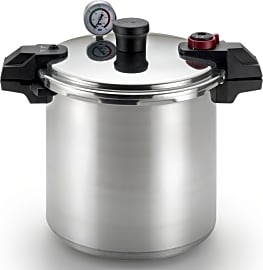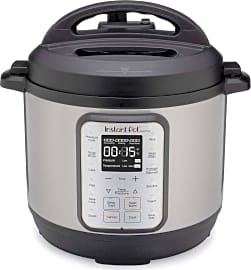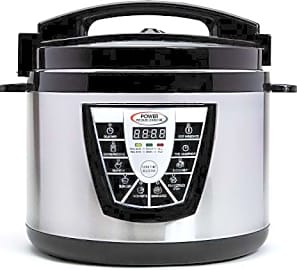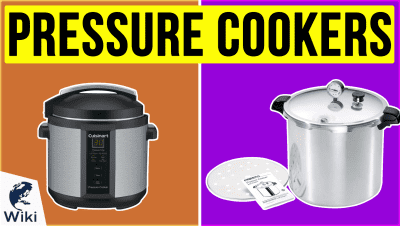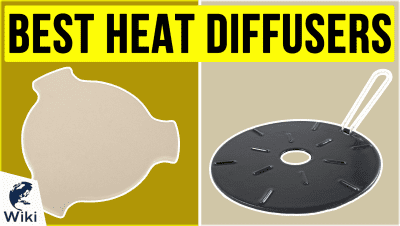The 7 Best Pressure Canners

This wiki has been updated 42 times since it was first published in August of 2015. Not only can these pressure canners be used to safely preserve fruits, vegetables, soups, sauces, and low-acid foods to keep a variety of fresh produce on hand throughout the year, but they can also help you get dinner on the table up to 70% faster than other cookware. They're ideal for flash-cooking dried beans, making delicious chili in minutes, and rendering meats that fall off the bone. When users buy our independently chosen editorial picks, we may earn commissions to help fund the Wiki.
Editor's Notes
May 21, 2021:
We made one simple but important update to the Wiki, which was the upgrade to the latest Instant Pot Duo Plus. This highly versatile appliance has a massive following for good reason, so as long as its 8-quart maximum capacity is big enough for your canning needs, it's one of the most convenient things you can have in a kitchen.
The rest of our rankings are unchanged, although we did remove a model that was similar to but more expensive than the Presto 615-1755 and T-fal P31052. Incidentally, both of those relatively simple options are pretty representative of the units the FDA uses to determine canning standards in the USA, so you can be sure they're up to the task. Serious cooks, however, will still prefer the All American 900 Series, which is about as heavy-duty as they get.
January 28, 2020:
Pressure canning might seem intimidating, and perhaps even a bit scary, to the uninitiated, but modern day canners actually make the process nearly fool proof, and most importantly, extremely safe for even the most inexperienced home cooks. Thanks to a variety of safety mechanisms, such as overpressure release valves, side gasket venting, weighted gauges that automatically keep the internal pressure at the correct PSI, and various other fail safes, the risk of one blowing up in the kitchen is practically nonexistent, unlike the pressure canners of old. That being said, it is still important to thoroughly read the manufacturer's instructions and follow them closely any time you use a pressure canner to avoid any potential accidents.
If you want the most user friendly experience possible, an electric model like the Instant Pot Max 9-in-1, Power Pressure Cooker XL, and Mueller UltraPot 6Q are probably the best options. Since they handle all of the hard work for you, such as maintaining the correct temperature and pressure, there is very little chance for user error. They also work well and have various settings to cook a wide range of other foods, such as yogurt, stews, rice, beans, and more. The downside of these though, is that they are generally smaller than stovetop options. For example, the Power Pressure Cooker XL, which is the largest of the three, only offers a 10-quart capacity. Comparatively, the All American 900-series is available with as much as a 41.5-quart capacity.
On that note, the All American 900-series is a good choice for professional chefs, as it offers a commercial-quality build, the previously mentioned large capacity, and six knobs that secure the lid safely in place during cooking. It also features a dial gauge to keep you abreast of the exact amount of pressure inside the pot, so you can tweak it as needed. Other models on our list that also include a dial gauge are the Presto 615-1755 and T-fal P31052.
Home users, however, may be better of with a model that is equipped with a weighted gauge, like the Granite Ware 0730-2 and Mirro 92122A. Rather than having to keep an eye on the dial, users simply select the five, 10, or 15 PSI gauge, and the pot will automatically stay at the pressure throughout the cooking process.
Special Honors
LEM Pressure Canner At 16 quarts, the LEM Pressure canner is just the right size for home use, without being so large that it is impossible for most to store in one of their kitchen cabinets. It is crafted from heavy-duty, warp-resistant aluminum that also resists scratches and staining, and it features a dial gauge for precise control over the pressure. lemproducts.com
Benefits Of A Pressure Canner
For those with food preservation on their minds, the conversation invariably leads to the necessity of a pressure canner.
For those with food preservation on their minds, the conversation invariably leads to the necessity of a pressure canner. Pressure canners allow for food preservation without the need for extra freezer space; as they can produce shelf-stable foods if used properly.
They also allow for food preservation without brine; which is especially beneficial for fruits and some vegetables which do not have a good taste when pickled. There is also some concern about the correlation between the intake of pickled vegetables and incidence of esophageal cancers; making a pressure canner an even more intelligent choice.
Pressure cooking is also a healthier option than most cooking methods. Whether sauteing or steaming; water soluble minerals are lost through normal cooking methods. Pressure canning rapidly heats the food while keeping it in a closed container; ensuring water soluble nutrients remain in the food where they belong.
Modern Pressure Canners
The idea for the pressure cooker arrived in the 17th century. A physicist by the name of Denis Papin was working on the properties of steam, and hypothesized that steam could be used to cook food more rapidly. His invention was called the steam digester; and worked in much the same way as modern pressure canners.
Most modern pressure canners are lightweight, thin-walled kettles; either connected to their own electrical power source or designed for easy use on any stove range.
The use of pressure cookers like these gained momentum over the next few centuries, and as early as 1924, cookbooks were written and distributed for early model pressure cookers. The important distinction between a pressure cooker and a pressure canner is that canners have the ability to hold pressure for the longer periods of time required for pressurization and sterilization of jarred goods.
Pressure canners for the home really began to take hold in the 1970s; when lightweight materials allowed for easier use and effective pressurization. They were fitted with a dial gauge, a vent pipe such as a petcock, and a safety fuse.
Most modern pressure canners are lightweight, thin-walled kettles; either connected to their own electrical power source or designed for easy use on any stove range. Modern pressure canners have removable racks which keep the cans upright, out of the boiling water, and away from the heat source. Pressure canners can be deep enough for one layer of quart-sized jars; or even two layers of pint sized jars. Other functioning parts of many pressure canners remain the same. They have a vent pipe, a locking feature, and a safety fuse. A modern pressure canner may still have a dial gauge for indicating the pressure; or it may be replaced by a digital gauge.
Using A Pressure Canner Correctly
It is very important to use a pressure canner correctly. Failing to do so can result in poor canning, causing food spoilage and bacterial growth that lead to foodborne illnesses.
The first step to operating a pressure canner is to ensure the canner itself is properly functioning. Even out of the box, A canner should be thoroughly cleaned; from gaskets and vent pipes to any mineral dust from the factory.
When the timed process is completed, turn off the heat and let the canner cool down naturally.
When centering a pressure canner over a burner; it is important that both the burner and the range are level. A pressure canner can be damaged if the burner is putting out too much heat. With electric pressure canners the heat output is controlled automatically; but if the pressure canner is used over a stove, it is important to keep the heat output steady.
Before turning the burner on, put the rack and hot water into the canner. If the amount of water is not specified with a given food, a good guideline is to use water to cover the bottom two to three inches inside the canner; with longer food processes requiring more water. There are many recommendations from the USDA regarding shelf-safe foods; and this is a good place to begin if the user has little knowledge on the topic.
The next step is to place the filled jars on the rack inside the pressure canner using a high quality jar lifter. When moving jars, the tool should be securely positioned below the neck of the jar; keeping the jar upright at all times. Tilting the jar could cause food to spill into the sealing area of the lid; compromising an effective seal.
When the jars are in place, securely fasten the canner lid; leaving the vent pipe or the petcock open. Turning the heat setting to its highest position, heat until the water boils and steam flows freely from the open vent pipe or petcock. After venting like this for ten minutes, seal the canner; allowing the canner to pressurize.
To keep the dial gauge at the recommended pressure, adjust the heat under the canner to maintain a steady level of pressurization. This is important; as loss of pressure at any time can result in under-processed or unsafe food. When the timed process is completed, turn off the heat and let the canner cool down naturally.


